|
Omega
Chronographs:
Instructions/Directions:
|
- Written
by Chuck
Maddox
 on 29 March 2002,
on 29 March 2002,
- Last
Revised: 29 March 2002, 17:31
GMT
- Certain
Rights Reserved...
|
Index/Shortcuts:
|
- Mark
III/Mark IV (Lemania 1342):
 Front,
Rear Front,
Rear- Mark
V (Lemania 5100):
 Instruction
Cover,
Features Instruction
Cover,
Features Composite,
Usage,
Setting,
Notes Composite,
Usage,
Setting,
Notes- Speedmaster
125:
 Cover_Text,
Operation,
Tachymeter Cover_Text,
Operation,
Tachymeter Telemetric,
Pulsimetric,
Decimal Telemetric,
Pulsimetric,
Decimal- flightmaster:
 Feature
Discriptions,
Usage, Feature
Discriptions,
Usage,
 Chronograph,
GMT,
Bezel Chronograph,
GMT,
Bezel- Acknowledgements
- Permissions/Rights
|
|
This document has Is basically recycling parts
and pieces of other projects that I have been and
am currently working on. This compilation is a
collection of materials related to the operations
of Omega Chronograph Watches. Some of the
individual instructions are applicable to other
brands of watches... For example watches from other
manufacturers which use the Lemania 1342 Base
Movement (Heuer, Tissot, Wakmann and also Omega)
can use the instructions for the Mark III/Mark IV
for example and ignore the elements that do not
appear on their particular chronographs (most often
the 24-Hour sub-dial). Likewise owners of Lemania
5100 base movement Chronographs (Omega,
Heuer/TAG-Heuer, Porsche Design Orfina, Tutima,
Sinn, Bell & Ross, Lemania, Tourneau, Revue
Thommen, Eberhardt, among many others) can use the
instructions for the Speedmaster Mark V, and ignore
instructions for any missing features (such as the
day indication.
|
|
|
|
|
Omega
Speedmaster Mark III/Mark IV
(Lemania
1342 Base):
|



|
|
Directions
Front:
|



|
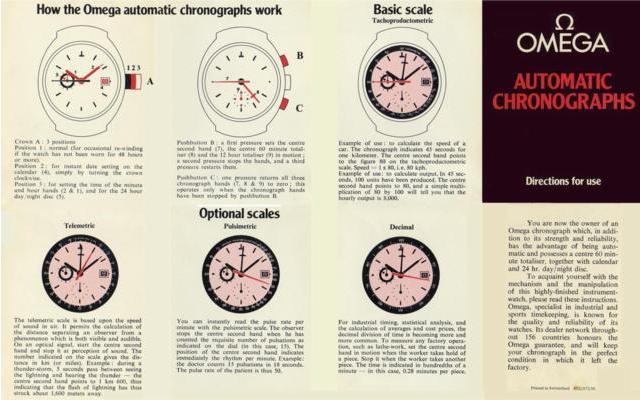 - Clicking
on the picture will open a new window with a
1280 x 800 pixel version of the
picture
|
|
Directions
Back:
|



|
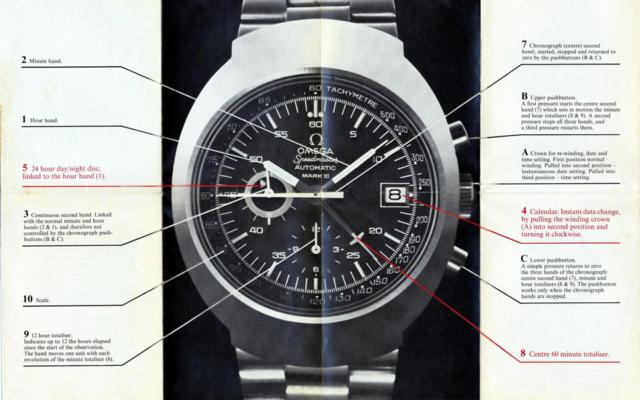 - Clicking
on the picture will open a new window with a
1280 x 800 pixel version of the
picture
|
|
Omega
Speedmaster Mark V / c.1045s
(Lemania
5100 Base):
|



|
|
Instructions
Cover:
|



|
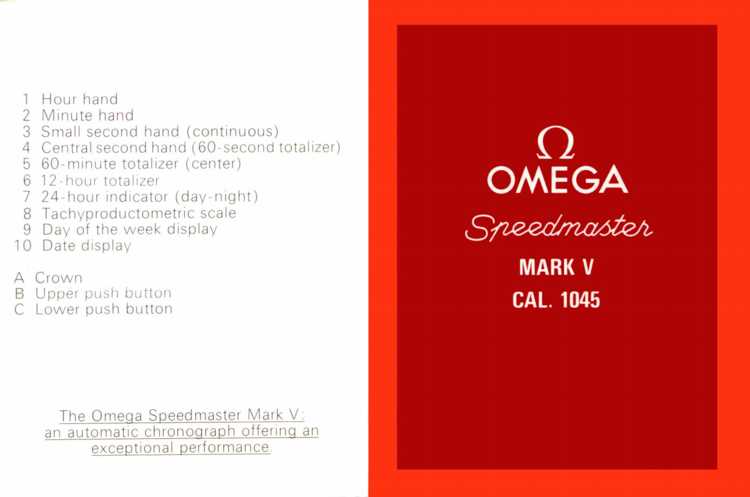 - The
cover and back panel of original manual for a
Mark V c.1045 (more
on this later)...
Click on picture to enlarge in a new
window...
|
|
Description
of Features:
|



|
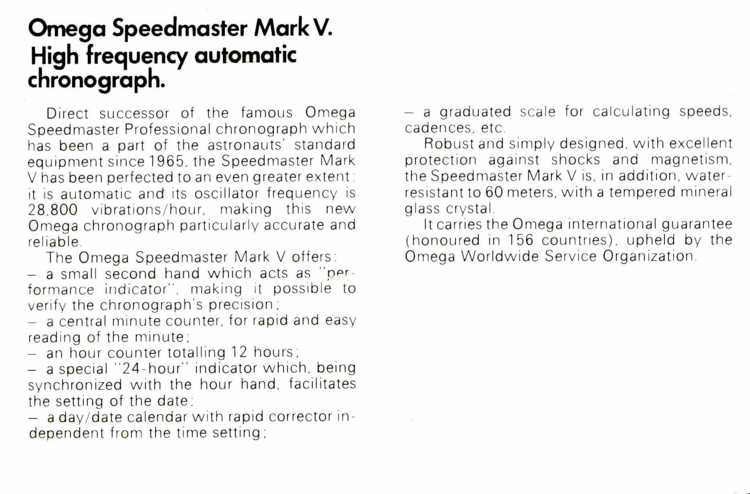 - Inside
first panel, Click on picture to enlarge in a
new window...
|
|
A
Composite Annotated Features List:
|



|
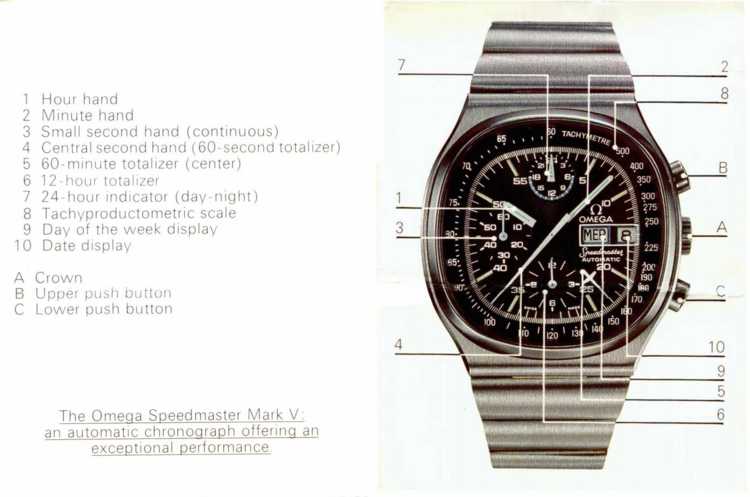 - A
composite graphic, not in
the manual, of an annotated diagram of
features, created by the author... Click on
picture to enlarge in a new
window...
|
|
How
to Use:
|



|
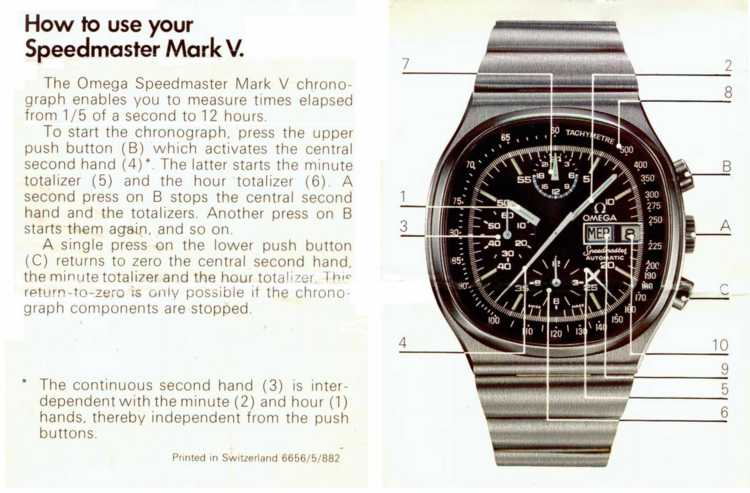 How
to use the watch... Click on picture to enlarge
in a new window... How
to use the watch... Click on picture to enlarge
in a new window...
|
|
Hot
to set the watch:
|



|
 - How
to set the watch... Click on picture to enlarge
in a new window...
|
|
Mark
V Instruction Manual Notes:
|



|
- This particular
instruction manual is an interesting document in
and of itself. By it's cover it is clearly
intended as an instruction manual for the 1984
production Speedmaster Mark V chronograph,
however it's internal photographs are of a
ST176.0017 which was produced in 1974~1977
(roughly). Here is the story on this manual as
best as I can reconstruct it without being a
pest to John Diethelm who heads up Omega's
Vintage Information Department... When Omega
came out with the Mark V in 1984, they needed an
instruction manual for it, but didn't have
pictures of the final product yet. So it seems
as if they used an ST176.0017 to stand in for
the ST376.0806 Mark V... An acceptable solution
since operationally the watches are identical.
Interestingly enough I have a German Language
versions of this same manual, with the same
photographs, etc. that I recieved with my Mark V
(Henk recieved his with a purchased
ST176.0012)... I probably could be persuaded to
scan it in if someone were to request it, once I
relocated it in the mess that is my work area...
Another interesting point about this manual is
that there is a rather glaring error in it that
is not immediately obvious... In fact I worked
on these files several hours before noticing
this issue. I'd be real interested to see if
anyone can spot it. In fact the first person to
spot it will get his or her name included here
in this document! (Sorry Henk, since you have
had advance access to these it's not really fair
to let you compete!)
-
- Thanks again to
Heng van de Weg of the Netherlands for his
contribution of these scans!
|
|
Speedmaster
125 (Lemania
1342 Base):
|



|
|
Cover
Text:
|



|
|
Omega
Speedmaster 125
|
|
the
automatic
chronograph-chronometer
|
|
Proud
Testimony to 125 years of
watchmaking
|
- "The
Omega Speedmaster 125 is a very special
watch. Very few were made. Not only is
it an automatic chronograph, but it
also carries the certificate of the
Swiss Institutes for Official
Chronometer Tests. This means that
along the will all the practical
advantages of a true chronograph, the
Speedmaster 125 has the uncompromising
timekeeping efficiency of an official
chronometer.
-
- Omega
has designed the Speedmaster 125 as a
commemorative watch for it's 125th
anniversary. It is the latest in the
Speedmaster line, the most
distinguished family of the watches in
Omega's history."
--
Excerpt from the Omega Speedmaster 125
Instruction manual
-
(Quotation
Courtesy of Simon
Debrux)
|
|
|
Operation:
|



|
- Main
features of the Speedmaster 125
|

--
Diagram inspired by one in the original
manual
|
|
- Three
position signed Omega
crown:
- Position
1 (normal operating
position):
- For
occasional rewinding of the watch if it
has not been warn for 48 hours or
more.
- Position
2 (For Instant Date
Setting):
- Pull
crown out to position 2 and turn the
crown clockwise until the date
indicated in the calendar window (4 in
diagram at left) is correct.
Note:
Before you try to set the date, make
sure that the time on the watch is
between 3 o'clock and 8 o'clock so that
you avoid binding the automatic date
change mechanism with the quick change
mechanism.
- Position
3 (Time Setting):
- Pull
crown out to position and turn the
crown until both the main dial hands
(1: Hour, 2: Minute) and the 24-Hour
arrow (5) are properly set.
-
- Other
items indicated in this
diagram:
- 1: Hour
Hand, 2: Minute Hand, 3: Second hand
(in sub-register at 9 o'clock), 4:
Calendar Date window, 5: 24-Hour Arrow,
6: Chronograph Second Indicator, 7:
Chronograph Minute Indicator, 8:
Chronograph Hour Indicator. Pusher A:
starts and stop's and restarts the
Chronograph, Pusher B: Resets the
Chronograph after the Chronograph has
been stopped.
|
|
|
Tachymeter:
|



|
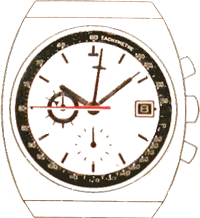
|
- Description:
Allows one to compute speeds and machine
outputs.
-
- Examples of
Use:
- 1) To
calculate the speed of a car over a known
distance press the top chronograph button when
entering the fixed distance press it again when
the fix distance. If the time elapsed is 45
seconds the second hand points to the figure 80
on the Tachy scale. If the fixed distance is a
Kilometer then the car is traveling 80
kilometers per hour. If the distance covered is
a mile, then the speed is indicated in Miles per
hour.
2) To calculate
the output of a machine, start the chronograph and
count a set number of units made, at the end of
this number stop the chronograph. If you counted to
1,000 and the second hand points to 75 on the Tachy
ring, the machine's hourly output is 75 time 100 or
7,500 units per hour.
|
|
Telemetric:
|



|
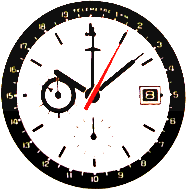
|
Description:
The Telemetric scale is graduated to indicate
the speed of sound in air. This allows the user to
calculate the distance between the observer and a
situation that is observable both visually and
audibly.
- Description of
Operation:
- On an optical
signal, start the chronograph. When you hear the
sound stop the chronograph. The number indicated
at the distance in kilometers or miles
(depending on scale).
-
- Examples of
Use:
At the flash of a bolt
of lightning start the chronograph. Stopping the
chronograph when you hear the thunder (in the case
of the diagram at left at 5 Seconds) will indicate
on the Telemetre ring 1.6 km or 1600 meters away
from the wearer of the watch. Sounds like a good
time to take cover! =)
|
|
Pulsimetric:
|



|
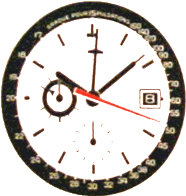
|
Description:
The Pulsimetric scale is graduated to indicate
the rate of respiration or pulse of a patient. This
allows the user to take a pulse or observe a
certain number of respirations and read off the
correct number of respiration/pulse per
minute.
Description of
Operation:
- The top
chronograph button is pressed at the beginning
of a pulse or respiration, it is pressed again
when the proper number of
pulsations/respirations has occurred. The proper
number of pulsations is indicated on the bezel
dial.
-
- Examples of
Use:
At the start of a
pulsation the operator starts the chronograph,
after the 15th pulse the operator stops the
chronograph at 18 seconds. Reading from the stopped
second hand to the Pulsimetric scale results in a
pulse rate of 50 beats per minute for this
patient.
|
|
Decimal:
|



|
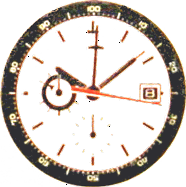
|
Description:
For industrial timing, statistical analysis,
calculation of averages and cost prices the use of
decimal division of time is common.
- Examples of
Operation:
- To measure the
length of time it takes to perform any operation
start the chronograph when work begins and stop
it when the work on the second piece begins.
This results in the amount of time to produce a
piece.
-
- Examples of
Use:
If a worker is fitting
a bracelet to a watch, an observer starts the
chronograph when the worker begins on a unit to be
assembled and stops it when the worker begins on
the second unit. The time read off the bezel
indicates the time this operation took in
hundredths of a minute, in the diagram at left 0.28
minutes per piece.
|
|
Omega
flightmaster:
|



|
|
Scans
from a c.910 Flightmaster instruction
manual:
|



|
- (information
courtesy of Stuart
Tentoni)
|
Produced
by people with their feet firmly on the
ground.
|
|
It's
easy to produce a chronograph with a
revolving bezel and then call it a pilot's
watch.
It's
not so easy to produce a functional
chronograph specifically for the
pilot.
Before
we even started to design the Flightmaster
we researched the needs of the pilot and
then we made sure that we covered those
needs - no more, no less.
The
result is the combined effort of designers
already experienced in producing
chronographs for the aviation world; and
Omega - supremely experienced in the
production of precision timepieces which
have proved reliable even in the extreme
conditions of space travel.
Every
part of the Flightmaster has been
carefully considered and the chronograph
born of the research design and
development is a practical instrument -
specially made for the pilot.
|
|
- The
Case:
Cut
from a single block of Swedish
stainless steel, the upper case is
pressed and tempered sixteen times
before it assumes it's unique
elliptical shape designed to fit the
countours of the wrist
comfortably.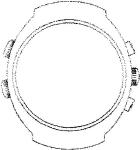 Normally,
the Flightmaster is equipped with a
stainless steel bracelet. But it also
comes with a Corfam® strap. The
strap has cool "air-conditioning" holes
and is designed with the anatomy of the
wrist in mind to assure a firm and
comfortable fit necessary with a watch
of the Flightmaster's
proportions. Normally,
the Flightmaster is equipped with a
stainless steel bracelet. But it also
comes with a Corfam® strap. The
strap has cool "air-conditioning" holes
and is designed with the anatomy of the
wrist in mind to assure a firm and
comfortable fit necessary with a watch
of the Flightmaster's
proportions.
|
|
 - Water
and Spaceproofing:
- After
the movement has been inserted into the
case and the stainless steel back
screwed into place, the tempered
mineral glass crytstal is sealed in
position by a unique jointing
system.
It
has been tested under space conditions and
works even in a complete vacuum
.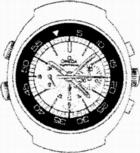
- Legibility:
- A
pilot's watch has many functions so the
visual aspect of the Flightmaster is a
particular feature.
|
|
Designed
for legibility the time zone hand have
been carefully placed to avoid confusion
with the whole face colour keyed to
strengthen the visual
separation.
Even
the winders and pushpieces have been keyed
to the face and although the red
chronograph hands are supplied as
standard, the Flightmaster is on special
request available with yellow hands to
allow for where aircraft cabins are lit
with infra-red light.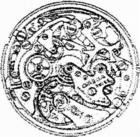
The
Movement:
The same people responsible for the
timeing devices used in the Olympics and
by the American astronauts are responsible
for the Flightmaster so you knoiw that
each of the moveing parts is a piece of
precision engineering designed for
accuracy and total reliability.
|
|
|
|
Overall
usage... The basics:
|



|
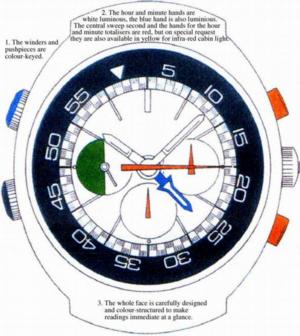 - Click
to enlarge
photos...
|
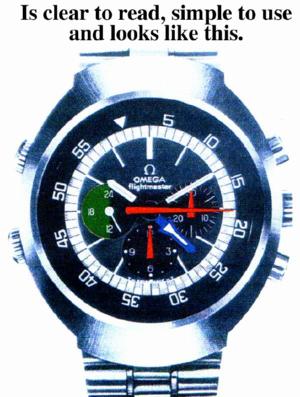
|
|
|
Chronograph
Operation:
|



|
 - Click
to enlarge
photos...
|
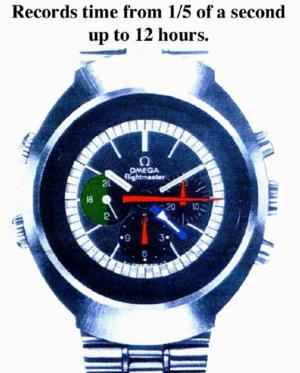
|
|
|
GMT
or Multiple Time Zone Operation:
|



|
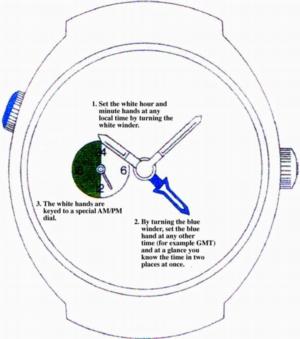 - Click
to enlarge
photos...
|
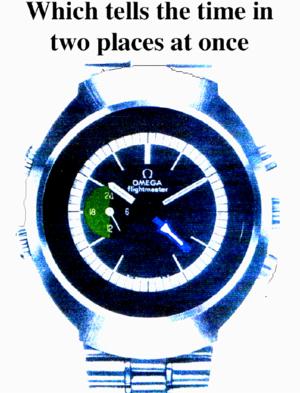
|
|
|
Operation
of the undercrystal Bezel:
|



|
 - Click
to enlarge
photos...
|
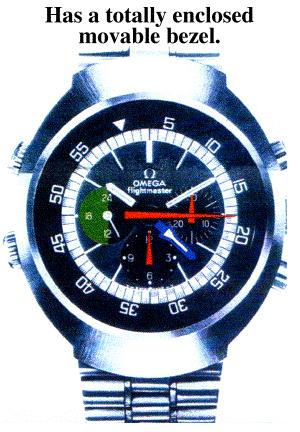
|
|
|
Acknowledgements:
|



|
|
I'd like to thank Simon Debrux of the United
Kingdom (Speedmaster 125), Heng
van de Weg of the Netherlands (Mark V),
Stuart Tentoni of the U.S.A. (flightmaster) for
their contributions to the scans presented here.
The scans for the Mark III are from an instruction
manual from my personal collection... I would also
like to thank John Diethelm of Omega Switzerland
for his ceaseless efforts in assisting the Omega
community to learn more about their watches.
|
|
Statement
of permissions/Rights Retained...
|


|
|
As the source materials of these scans have no
copyright expressed on them, I consider them in the
public domain. So they may be used freely.
However... it is always morally, ethically,
legally and polietly important that these scans not
be used fraudulently or be misrepresented as
genuine documents... It occurs to me that someone
with a talent with Desktop publishing tools could
use these scans to produce convincing replicas of
original documents. Please don't...
It is also a common courtesy to inform people whom
you print out copies of these scans of the source
of these documents. I and the other people who have
contributed these materials in good faith would
appreciate your respecting the spirit of these
thoughts. The commentary within this document is
reserved by the author.
That's it. I think it's fair enough...
Enjoy!
-- Chuck
|
|